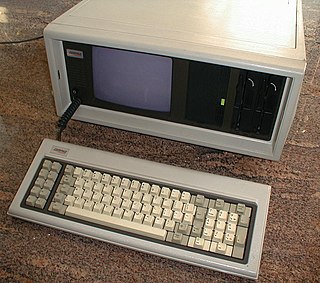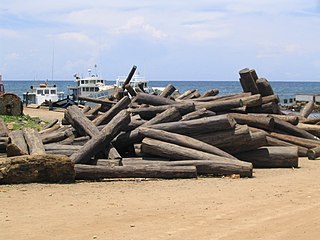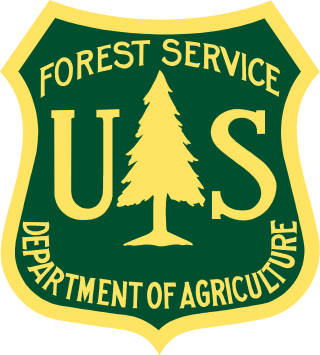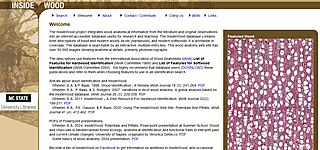
A barcode or bar code is a method of representing data in a visual, machine-readable form. Initially, barcodes represented data by varying the widths, spacings and sizes of parallel lines. These barcodes, now commonly referred to as linear or one-dimensional (1D), can be scanned by special optical scanners, called barcode readers, of which there are several types.
Digital Imaging and Communications in Medicine (DICOM) is a technical standard for the digital storage and transmission of medical images and related information. It includes a file format definition, which specifies the structure of a DICOM file, as well as a network communication protocol that uses TCP/IP to communicate between systems. The primary purpose of the standard is to facilitate communication between the software and hardware entities involved in medical imaging, especially those that are created by different manufacturers. Entities that utilize DICOM files include components of picture archiving and communication systems (PACS), such as imaging machines (modalities), radiological information systems (RIS), scanners, printers, computing servers, and networking hardware.

A portable computer is a computer designed to be easily moved from one place to another, as opposed to those designed to remain stationary at a single location such as desktops and workstations. These computers usually include a display and keyboard that are directly connected to the main case, all sharing a single power plug together, much like later desktop computers called all-in-ones (AIO) that integrate the system's internal components into the same case as the display. In modern usage, a portable computer usually refers to a very light and compact personal computer such as a laptop, subnotebook or handheld PC, while touchscreen-based handheld ("palmtop") devices such as tablet, phablet and smartphone are called mobile devices instead.

Illegal logging is the harvest, transportation, purchase, or sale of timber in violation of laws. The harvesting procedure itself may be illegal, including using corrupt means to gain access to forests; extraction without permission, or from a protected area; the cutting down of protected species; or the extraction of timber in excess of agreed limits. Illegal logging is a driving force for a number of environmental issues such as deforestation, soil erosion and biodiversity loss which can drive larger-scale environmental crises such as climate change and other forms of environmental degradation.

A structural insulated panel, or structural insulating panel, (SIP), is a form of sandwich panel used in the construction industry.

X-ray spectroscopy is a general term for several spectroscopic techniques for characterization of materials by using x-ray radiation.

The Forest Products Laboratory (FPL) is the national research laboratory of the United States Forest Service, which is part of USDA. Since its opening in 1910, the FPL has provided scientific research on wood, wood products and their commercial uses in partnership with academia, industry, tribal, state, local and other government agencies. The laboratory is headquartered in Madison, Wisconsin. The focus of the Forest Products Laboratory is to promote healthy forests and forest-based economies through the efficient, sustainable use of the Nation's wood resources.
BTRON is one of the subprojects of the TRON Project proposed by Ken Sakamura, which is responsible for the business phase. It refers to the operating systems (OS), keyboards, peripheral interface specifications, and other items related to personal computers (PCs) that were developed there.

Wood anatomy is a scientific sub-area of wood science, which examines the variations in xylem anatomical characteristics across trees, shrubs, and herbaceous species to explore inquiries related to plant function, growth, and the environment.

Ernest Walter Thomas Cooper was the first Wildlife Inspector in Canada. He was formerly the Director for the conservation organization WWF-Canada and the Canadian National Representative of TRAFFIC the global wildlife trade monitoring network. He left WWF and TRAFFIC in 2014, and formed an environmental consulting business, specialising in wildlife trade issues. In 2009, an article in Canadian Geographic referred to Cooper as "Canada’s top wildlife-trafficking investigator."

The University of Washington Department of Bioengineering is a joint department between the College of Engineering and the School of Medicine of the University of Washington, located in Seattle, Washington.
Project Digits is a Microsoft Research Project under Microsoft's computer science laboratory at the University of Cambridge; researchers from Newcastle University and University of Crete are also involved in this project. Project is led by David Kim, a Microsoft Research PhD and also a PhD student in computer science at Newcastle University. Digits is an input device which can be mounted on the wrist of human hand and it captures and displays a complete 3D graphical representation of the user's hand on screen without using any external sensing device or hand covering material like data gloves. This project aims to make gesture-controlled interfaces completely hands free with greater mobility and accuracy. It allows user to interact with whatever hardware while moving from room to room or walking down the street without any line of sight connection with the hardware.
Beats Pill is a line of portable Bluetooth speakers produced by Beats Electronics, presently a subsidiary of Apple Inc. The speakers are characterized primarily by their capsule-like form factor. Several models have been released of the Pill since their launch in 2012, with the most recent version released in 2024.
Liquid Image Corporation was a Winnipeg-based company that manufactured head-mounted displays. The company formed in 1992 by Tony Havelka, David Collette and Shannon O'Brien. Liquid Image was started in Winnipeg, MB in response to the emergence of a market for virtual reality technology. Funding as provided by a group of local angels and the first office was in the attic of Tony Havelka.

Institute of Wood Science and Technology (IWST) is a Research institute situated in Bangalore in Karnataka. It works under the Indian Council of Forestry Research and Education (ICFRE) of the Ministry of Environment and Forests, Govt. of India. It is recognized to be a Centre of Excellence for Sandalwood Research and Wood Science

Wood science is the scientific field which predominantly studies and investigates elements associated with the formation, the physical and chemical composition, and the macro- and microstructure of wood as a bio-based and lignocellulosic material. Wood science additionally delves into the biological, chemical, physical, and mechanical properties and characteristics of wood as a natural material.

The Old U.S. Forest Products Laboratory, built in 1910 in Madison, Wisconsin, housed a new national lab, and the first institution in the world created specifically to research wood and wood products. Research in this building produced breakthroughs in wood preservation, laminates, and paper production. The building itself is a good example of Georgian Revival-style architecture. In 1985 the building was added to the National Register of Historic Places.

The Wood Reference Collection is a Queensland Government scientific collection based in Queensland, Australia. It is the oldest xylotheque of authenticated wood specimens in Australia and the third largest in the nation. It consists of 21 separate collections of wood block samples, including 17 international collections, and a glass slide collection of timber microstructure sections. Together, they provide a comprehensive reference collection of anatomical characteristics for Queensland timbers, and some national and international timbers.

InsideWood is an online resource and database for wood anatomy, serving as a reference, research, and teaching tool. Wood anatomy is a sub-area within the discipline of wood science. This freely accessible database is purely scientific and noncommercial. It was actually created by several international researchers, members of the IAWA, mostly botanists, biologists and wood scientists.

Gerald Koch is a German wood scientist and professor, senior researcher and research scientific director at the Thünen-Institute of Wood Research at Hamburg, who is an elected fellow of the International Academy of Wood Science.















